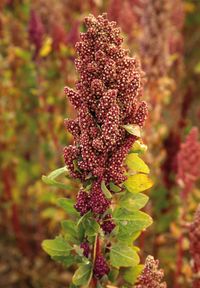The rediscovery of Quinoa
Quinoa is a traditional crop of the Andean highlands. It is adapted to marginal soils and the harsh climate and is a source of high-quality protein and important minerals. However, production of qui-noa declined because imported wheat was cheaper. Since the beginning of the 1980s the quinoa crop has been experiencing a revival, and quinoa products are now on the shelves of every organic supermarket. In Bolivia, the national association of quinoa producers, ANAPQUI, founded in 1983, promotes cultivation of the crop. Some is exported to the USA and Europe, but innovative products such as quinoa pasta and snacks have also been developed for the domestic market. European fair trade organisations and the private enterprise “Coronilla” in Cochabamba, Bolivia, are reliable partners for these activities. This means higher and more stable prices for farmers as well as the creation of new jobs in processing and marketing.
|
 |} |}
Better access to food through new sources of income
A further cause of food insecurity is chronic or temporary shortage of money. Even if food is available in sufficient quantity and quality, not everyone has the resources to buy it. Improving the income situation of such people is an essential part of improving food security. Special, often little-known plant varieties and livestock breeds offer potential for income generation. This may involve processing to food, medicines, cosmetics and craft products, or developing new markets and market niches for such products. The organic and fair trade markets provide potential for long-term initiatives in these areas.
Harmonizing food aid and agrobiodiversity
In times of acute food insecurity, people need immediate help. Food aid may be provided either as pure humanitarian aid or as part of rehabilitation programmes such as those involving “food for work”. In addition, in countries such as India poor people regularly receive subsidies, for example in the form of vouchers or ration cards which can be used to buystaple foods at subsidised prices.This has an impact on local food markets and the diversity of the produce available there. While the effect on prices is temporary, food aid – usually provided in the form of maize, rice or wheat – can bring about a long- term change in food habits, reducing the demand for tra-ditional products. Over a prolonged period food aid can be counterproductive for local agriculture. It is therefore important to align food aid with longer-term development goals, such as the conservation of biological diversity.
Obstacles and Opportunities
The greatest opportunity for the conservation of agrobio diversity in the context of food security is perhaps at the same time the greatest obstacle. A decentralised approach is required, based on local knowledge, local resources and “on the ground” activities. This in turn needs local leadership and local implementation capacities. The problems to be addressed concern primarily the following areas:
Knowledge
Existing knowledge and experience needs to be collected and evaluated, and public awareness of the link between agrobiodiversity and food security must be promoted.
Scope
Measurable effects can only be achieved if schemes are supra-regional in concept but at the same time take account of different local and cultural requirements.
Institutional development
Wider implementation is hampered by the limited involvement of the rural population in national and international programmes. Another obstacle is the lack of coordination between individual sectors and disciplines, such as those involved in the conservation of biological diversity, agricultural development, food security and health. Diversity conservation must form a fundamental part of policies and programmes relating to poverty re-duction, agriculture, health and nutrition. This means that it must be integrated into food security projects, emergency response measures, national poverty reduction strategies, agricultural policy programmes and guidelines, and school nutrition programmes.
It may not be possible to achieve large-scale results in the short term by means of this approach. It nevertheless offers a unique opportunity to link food security measures with other development goals such as education, the empowerment of women, or the protection of resources and the environment. The importance which agrobiodiversity had in the past for the survival of humankind would then take on a new dimension.
References and further information:
GIZ (2011): Sourcebook on Sustainable Agrobiodiversity Management
BMZ (2003): Ernährungssicherung in der Entwicklungszu- sammenarbeit. Übersektorales Konzept (draft version). BMZ, Bonn/Germany.
FAO (2005): The state of food insecurity in the world. FAO, Rome (www.fao.org/documents).
Garí, J. A. (2004): Plant diversity, sustainable rural liveli- hoods and the HIV/AIDS crisis. FAO, Rome and UNDP, Bangkok.
GTZ (2005): Home gardens – treasure troves of diversity. Issue papers People & Biodiversity. GTZ, Eschborn/ Germany.
IPGRI, GFU and MSSRF (2005): Agricultural biodiversity and elimination of hunger and poverty. The Chennai plat- form for action.
|